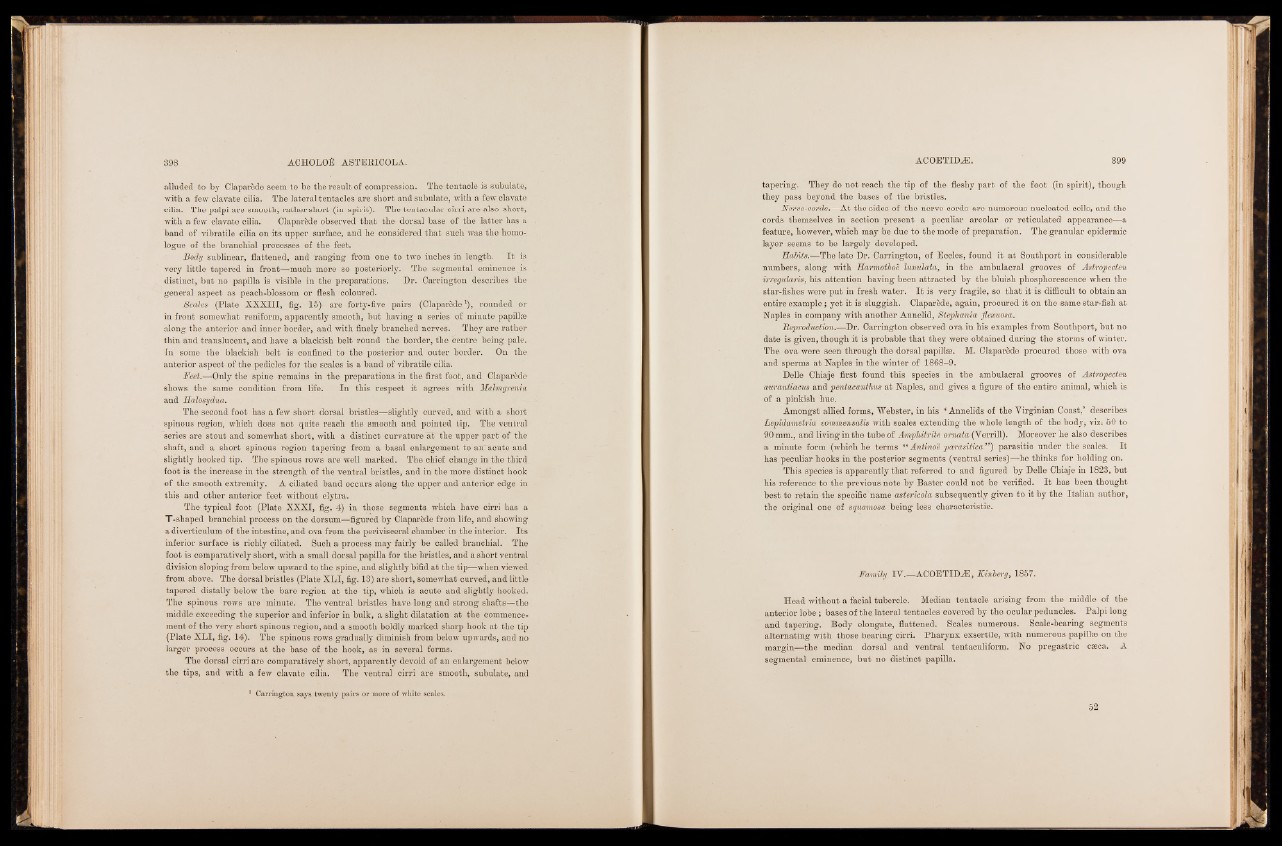
alluded to by Claparède seem to be the result of compression. The tentacle is subulate,
with a few clavate cilia. The lateral tentacles are short and subulate, with a few clavate
cilia. The palpi are smooth, rather short (in spirit). The tentacular cirri are also short,
with a few clavate cilia. Claparède observed that the dorsal base of the latter has a
band of vibratile cilia on its upper surface, and he considered that such was the homologue
of the branchial processes of the feet.
Body sublinear, flattened, and ranging from one to two inches in length. I t is
very little tapered in front—much more so posteriorly. The segmental eminence is
distinct, but no papilla is visible in the preparations. Dr. Carrington describes the
general aspect as peach-blossom or flesh coloured.
Scales (Plate XXXIII, fig. 15) are forty-five pairs (Claparède1), rounded or
in front somewhat reniform, apparently smooth, but having a series of minute papillæ
along the anterior and inner border, and with finely branched nerves. They are rather
thin and translucent, and have a blackish belt round the border, the centre being pale.
In some the blackish belt is confined to the posterior and outer border. On the
anterior aspect of the pedicles for the scales is a band of vibratile cilia.
Feet.—Only the spine remains in the preparations in the first foot, and Claparède
shows the same condition from life. In this respect it agrees with Malmgrenia
and Halosydna.
The second foot has a few short dorsal bristles—slightly curved, and with a short
spinous region, which does not quite reach the smooth and pointed tip. The ventral
series are stout and somewhat short, with a distinct curvature alTthe upper part of the
shaft, and a short spinous region tapering from a basal enlargement to an acute and
slightly hooked tip. The spinous rows are well marked. The chief change in the third
foot is the increase in the strength of the ventral bristles, and in the more distinct hook
of the smooth extremity. A ciliated band occurs along the upper and anterior edge in
this and other anterior feet without elytra.
The typical foot (Plate XXXI, fig. 4) in those segments which have cirri has a
T-shaped branchial process on the dorsum—figured by Claparède from life, and showing
a diverticulum of the intestine, and ova from the perivisceral chamber in the interior. Its
inferior surface is richly ciliated. Such a process may fairly be called branchial. The
foot is comparatively short, with a small dorsal papilla for the bristles, and a short ventral
division sloping from below upward to the spine, and slightly bifid at the tip—when viewed
from above. The dorsal bristles (Plate XLI, fig. 13) are short, somewhat curved, and little
tapered distally below the bare region at the tip, which is acute and slightly hooked.
The spinous rows are minute. The ventral bristles have long and strong shafts—the
middle exceeding the superior and inferior in bulk, a slight dilatation at the commencement
of the very short spinous region, and a smooth boldly marked sharp hook at the tip
(Plate XLI, fig. 14). The spinous rows gradually diminish from below upwards, and no
larger process occurs at the base of the hook, as in several forms.
The dorsal cirri are comparatively short, apparently devoid of an enlargement below
the tips, and with a few clavate cilia. The ventral cirri are smooth, subulate, and
1 Carrington says twenty pairs or more of white scales.
tapering. They do not reach the tip of the fleshy part of the foot (in spirit), though
they pass beyond the bases of the bristles.
Nerve-cords.—At the sides of the nerve-cords are numerous nucleated cells, and the
cords themselves in section present a peculiar areolar or reticulated appearance—a
feature, however, which may be due to the mode of preparation. The granular epidermic
layer seems to be largely developed.
Habits.—The late Dr. Carrington, of Ecoles, found it at Southport in considerable
numbers, along with Harmothoë lunulata, in the ambulacra! grooves of Astropecten
i/tTegularis, his attention having been attracted by the bluish phosphorescence when the
star-fishes were put in fresh water. I t is very fragile, so that it is difficult to obtain an
entire example ; yet it is sluggish. Claparède, again, procured it on the same star-fish at
Naples in company with another Annelid, Stephania flexuosa.
Reproduction.—Dr. Carrington observed ova in his examples from Southport, but no
date is given, though it is probable that they were obtained during the storms of winter.
The ova were seen through the dorsal papillæ. M. Claparède procured those with ova
and sperms at Naples in the winter of 1868—9.
Delle Chiaje first found this species in the ambulacral grooves of Astropecten
aurantiacus and pentacanthus at Naples, and gives a figure of the entire animal, which is
of a pinkish hue.
Amongst allied forms, Webster, in his ‘Annelids of the Virginian Coast,’ describes
Lepidametria commensalis with scales extending the whole length of the body, viz. 50 to
90 mm., and living in the tube of Amphitrite ornata (Verrill). Moreover he also describes
a minute form (which he terms (< Antinoë parasitica”) parasitic under the scales. It
has peculiar hooks in the posterior segments (ventral series)—he thinks for holding on.
This species is apparently that referred to and figured by Delle Chiaje in 1823, but
his reference to the previous note by Baster could not be verified. It has been thought
best to retain the specific name astericola subsequently given to it by the Italian author,
the original one of squamosa being less characteristic.
Family IV.—ACOETIDiE, Kinberg, 1857.
Head without a facial tubercle. Median tentacle arising from the middle of the
anterior lobe; bases of the lateral tentacles covered by the ocular peduncles. Palpi long
and tapering. Body elongate, flattened. Scales numerous. Scale-bearing segments
alternating with those bearing cirri. Pharynx exsertile, with numerous papillaa on the
margin—the median dorsal and ventral tentaculiform. No pregastric casca. A
segmental eminence, but no distinct papilla.